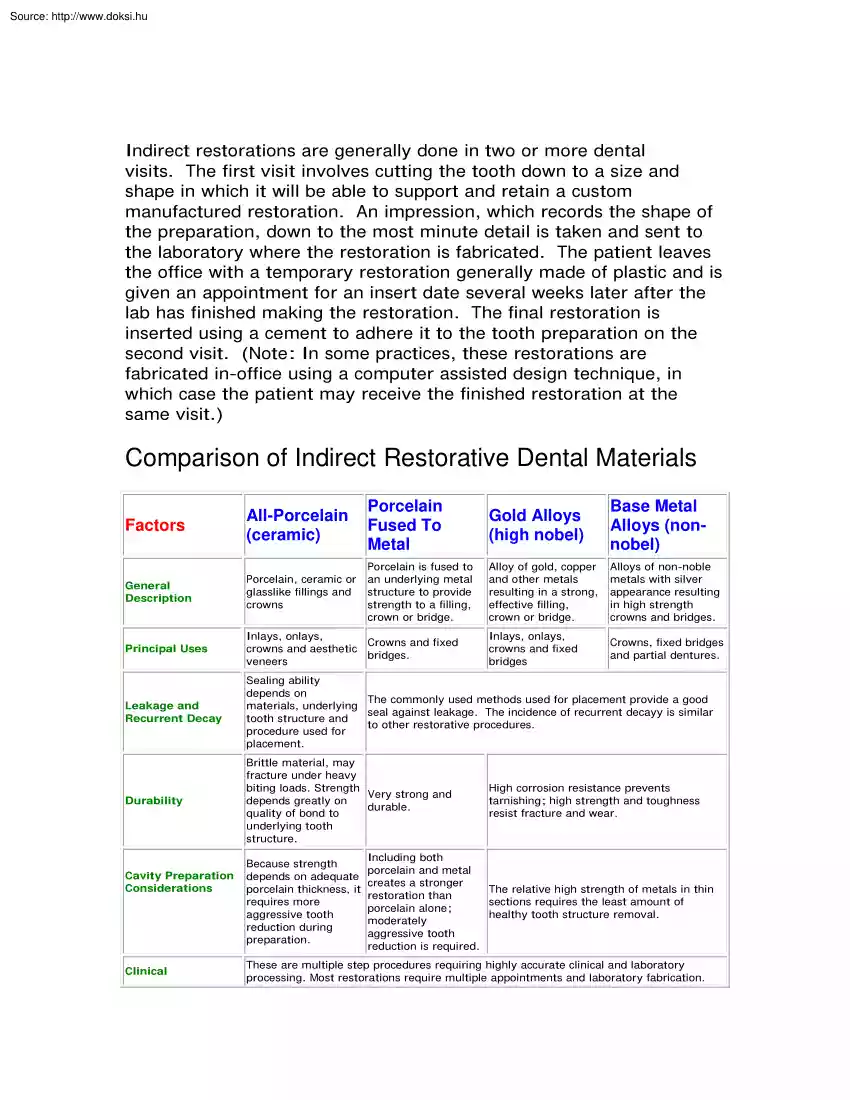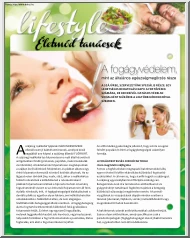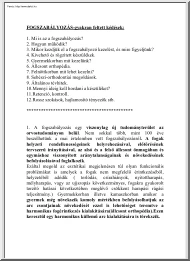Datasheet
Year, pagecount:2004, 2 page(s)
Language:English
Downloads:8
Uploaded:November 25, 2011
Size:26 KB
Institution:
-
Comments:
Attachment:-
Download in PDF:Please log in!
Comments
No comments yet. You can be the first!
Most popular documents in this category
Content extract
Indirect restorations are generally done in two or more dental visits. The first visit involves cutting the tooth down to a size and shape in which it will be able to support and retain a custom manufactured restoration. An impression, which records the shape of the preparation, down to the most minute detail is taken and sent to the laboratory where the restoration is fabricated. The patient leaves the office with a temporary restoration generally made of plastic and is given an appointment for an insert date several weeks later after the lab has finished making the restoration. The final restoration is inserted using a cement to adhere it to the tooth preparation on the second visit. (Note: In some practices, these restorations are fabricated in-office using a computer assisted design technique, in which case the patient may receive the finished restoration at the same visit.) Comparison of Indirect Restorative Dental Materials Factors All-Porcelain (ceramic) Porcelain Fused To
Metal Gold Alloys (high nobel) Base Metal Alloys (nonnobel) General Description Porcelain, ceramic or glasslike fillings and crowns Porcelain is fused to an underlying metal structure to provide strength to a filling, crown or bridge. Alloy of gold, copper and other metals resulting in a strong, effective filling, crown or bridge. Alloys of non-noble metals with silver appearance resulting in high strength crowns and bridges. Principal Uses Inlays, onlays, Crowns and fixed crowns and aesthetic bridges. veneers Inlays, onlays, crowns and fixed bridges Crowns, fixed bridges and partial dentures. Leakage and Recurrent Decay Sealing ability depends on The commonly used methods used for placement provide a good materials, underlying seal against leakage. The incidence of recurrent decayy is similar tooth structure and to other restorative procedures. procedure used for placement. Durability Brittle material, may fracture under heavy biting loads. Strength Very strong and
depends greatly on durable. quality of bond to underlying tooth structure. Cavity Preparation Considerations Clinical Because strength depends on adequate porcelain thickness, it requires more aggressive tooth reduction during preparation. High corrosion resistance prevents tarnishing; high strength and toughness resist fracture and wear. Including both porcelain and metal creates a stronger The relative high strength of metals in thin restoration than sections requires the least amount of porcelain alone; healthy tooth structure removal. moderately aggressive tooth reduction is required. These are multiple step procedures requiring highly accurate clinical and laboratory processing. Most restorations require multiple appointments and laboratory fabrication Considerations Highly resistant to wear, but porcelain can rapidly wear Resistance to Wear opposing teeth if its surface becomes rough. Resistance to Fracture Biocompatibility Highly resistant to wear, but porcelain can
rapidly wear opposing teeth if its surface becomes rough. Porcelain is prone to Prone to fracture impact Highly when placed under resistant to fracture. tension or on impact. fracture; the metal has high strength. Well tolerated. Well tolerated, but some patients may show allergenic sensitivity to base metals. Resistant to wear and gentle to opposing teeth. Highly resistant to fracture. Well tolerated. Well tolerated, but some patients may show allergenic sensitivity to base metals. Sensitivity, if present, is usually not material specific. Low thermal conductivity reduces the likelihood of discomfort from hot and cold. High thermal conductivity may result in early post-placement discomfort from hot and cold. Esthetics Color and translucency mimic natural tooth appearance. Porcelain can mimic natural tooth appearance, but metal limits translucency. Relative Cost to patient Higher; requires at least two Patient office visits and laboratory services. Post-Placement
Sensitivity Metal colors do not mimic natural teeth. Minimum of two; Minimum of two; Average Number of matching esthetics of matching esthetics of Minimum of two. Visits to Complete teeth may require teeth may require more visits. more visits
Metal Gold Alloys (high nobel) Base Metal Alloys (nonnobel) General Description Porcelain, ceramic or glasslike fillings and crowns Porcelain is fused to an underlying metal structure to provide strength to a filling, crown or bridge. Alloy of gold, copper and other metals resulting in a strong, effective filling, crown or bridge. Alloys of non-noble metals with silver appearance resulting in high strength crowns and bridges. Principal Uses Inlays, onlays, Crowns and fixed crowns and aesthetic bridges. veneers Inlays, onlays, crowns and fixed bridges Crowns, fixed bridges and partial dentures. Leakage and Recurrent Decay Sealing ability depends on The commonly used methods used for placement provide a good materials, underlying seal against leakage. The incidence of recurrent decayy is similar tooth structure and to other restorative procedures. procedure used for placement. Durability Brittle material, may fracture under heavy biting loads. Strength Very strong and
depends greatly on durable. quality of bond to underlying tooth structure. Cavity Preparation Considerations Clinical Because strength depends on adequate porcelain thickness, it requires more aggressive tooth reduction during preparation. High corrosion resistance prevents tarnishing; high strength and toughness resist fracture and wear. Including both porcelain and metal creates a stronger The relative high strength of metals in thin restoration than sections requires the least amount of porcelain alone; healthy tooth structure removal. moderately aggressive tooth reduction is required. These are multiple step procedures requiring highly accurate clinical and laboratory processing. Most restorations require multiple appointments and laboratory fabrication Considerations Highly resistant to wear, but porcelain can rapidly wear Resistance to Wear opposing teeth if its surface becomes rough. Resistance to Fracture Biocompatibility Highly resistant to wear, but porcelain can
rapidly wear opposing teeth if its surface becomes rough. Porcelain is prone to Prone to fracture impact Highly when placed under resistant to fracture. tension or on impact. fracture; the metal has high strength. Well tolerated. Well tolerated, but some patients may show allergenic sensitivity to base metals. Resistant to wear and gentle to opposing teeth. Highly resistant to fracture. Well tolerated. Well tolerated, but some patients may show allergenic sensitivity to base metals. Sensitivity, if present, is usually not material specific. Low thermal conductivity reduces the likelihood of discomfort from hot and cold. High thermal conductivity may result in early post-placement discomfort from hot and cold. Esthetics Color and translucency mimic natural tooth appearance. Porcelain can mimic natural tooth appearance, but metal limits translucency. Relative Cost to patient Higher; requires at least two Patient office visits and laboratory services. Post-Placement
Sensitivity Metal colors do not mimic natural teeth. Minimum of two; Minimum of two; Average Number of matching esthetics of matching esthetics of Minimum of two. Visits to Complete teeth may require teeth may require more visits. more visits





